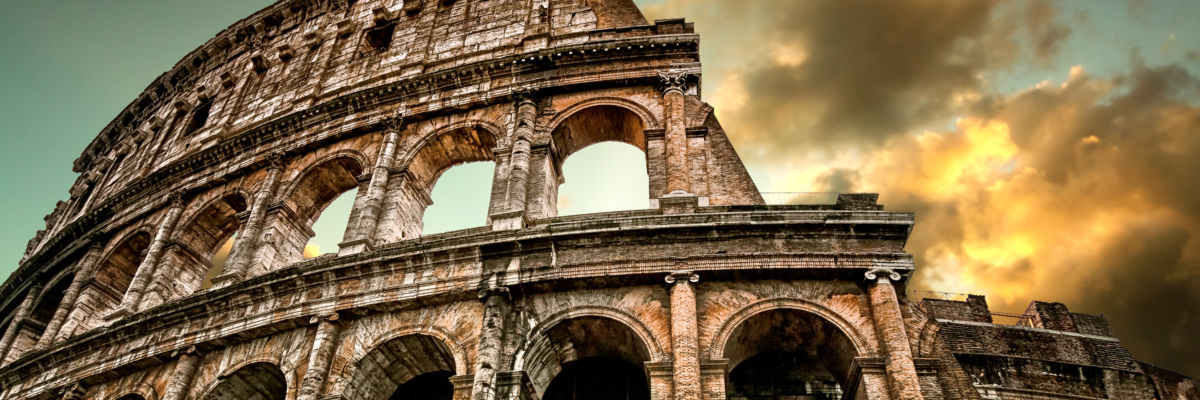
The Ardennes region of France lies in the northeast of the country, abutting the Belgian border. It is far from Rome—about 900 road miles—but not so far that the Emperor Napoleon III hesitated to recall the troops that had been garrisoning the Eternal City. He needed them in his difficult war with Prussia. As it turned out, they did him little good.
On September 1, 1870, at Sedan, French troops led by Napoleon were cut off and surrounded by Prussian forces. The next day the French raised the white flag. The Emperor surrendered his sword to the Prussian king, Wilhelm I, and to Field Marshall Helmuth von Moltke. A well-known painting by Wilhelm Camphausen, an official artist for the victorious army, shows Napoleon later conversing outside a Sedan house with Prussian Chancellor Otto von Bismarck.
The last French monarch went into exile in England, where he died in 1873. His last words were, “Isn’t it true that we weren’t cowards at Sedan?”
It was true, but the French humiliation on the field rankled for decades, even among republicans who were happy to see the end of the monarchy. Although the Emperor had been treated well, the French people as a whole—or at least the politicians who succeeded to power—thought their country had been treated poorly by the victors. They vowed not to forget, and they didn’t.
Half a century later, Napoleon’s successor as head of state, Georges Clemenceau, ignored Benedict XV’s pleas for a just peace at the conclusion of the Great War. Joined by a foolish American president, Woodrow Wilson, and a weak British prime minister, David Lloyd George, Clemenceau saw that the Treaty of Versailles burdened Germany with onerous reparations and economic penalties. This laid the groundwork for a larger war that would be fought by the next generation, a war in which the French would suffer another humiliation as German soldiers marched into Paris in 1940.
Unhappy consequences
In the long term, Sedan had unhappy consequences for the whole of Europe. In the short term, it had unhappy consequences for Pius IX, who reigned as pope from 1848 to 1878.
The withdrawal of French troops from Rome may have done nothing to alter the fate of the French army, but it guaranteed the fall of Rome to the army of the new Italian state. With the protecting French troops gone, Rome was left defenseless. On September 20 the city fell almost bloodlessly to the Kingdom of Italy. This event is memorialized in nearly every Italian town with a street named Via XX Settembre. Rome became the capital of a united Italy for the first time since the fall of the Roman Empire.
The taking of Rome was the last episode in the long campaign for Italian unification, a process known as the Risorgimento. Some scholars place the beginning of the Risorgimento as early as the 1815 Congress of Vienna. While other countries found themselves, at the end of the Napoleonic Wars, with fairly stable and unified structures, Italy found itself much as it long had been—a conglomeration of small states, some of them controlled by foreign powers. The largest was the Bourbon-ruled Kingdom of the Two Sicilies, comprising the southern half of the Italian peninsula and the island of Sicily. At the other end of the Italian domains was Piedmont, which, after combining with Sardinia, would come to unite the fractious states.
By 1860 nearly all of today’s Italy, except for Venetia and the city of Rome, had been united under Vittorio Emanuele II, who the next year was declared King of Italy. Venetia joined the new Italian state in 1866. That left only Rome, which was protected by French troops. The remainder of the Papal States, which had stretched through Umbria, Marche, and into Romagna and the area around Bologna, had been annexed by the Kingdom of Italy in 1860.
The reign of Pius IX
When Pius IX was elected pope in 1846, he was perceived as fairly liberal by the political standards of the day. Pio Nono, as he was known in Italian, succeeded Gregory XVI, considered by many historians to have been the most reactionary pope of the nineteenth century. His political policies had been widely unpopular—not just among anti-clerical elements but even among loyal Catholics. (For example, he opposed the introduction of gas lighting and railroads, fearful that they would increase the power of the bourgeoisie by promoting economic development.)
Gregory died aged eighty. Pius was a youngish fifty-four. As his first official act, the new pope granted a generous amnesty for political prisoners. The people of Rome thanked him with a torchlight parade. They even unhooked the horses from his carriage and pulled it themselves, cheering him as they did. They expected great changes.
Pius was willing to make accommodations with promoters of the Risorgimento, but there were limits. “We will cede as long as our conscience permits us, but arriving at the limit which we have already pre-established, we will not, with the help of God, go beyond it by one step, even if they tear us to pieces.” Over the years Pius remained true to those sentiments, which included an unwillingness to have the Papal States become part of the growing Kingdom of Italy.
Before Rome fell, Vittorio Emanuele offered the pope a face-saving plan that would allow the peaceful entrance of the Italian troops and protection for the pope. The Italian state offered Pius the Leonine City, the section of Rome, on the right bank of the Tiber, around which Pope Leo IV had a wall erected in the ninth century. Present-day Vatican City, which has an area of only 109 acres, is entirely within the Leonine City, which is much larger and extends, lozenge-shaped, to the east to encompass Castel Sant’Angelo and the rione (district) of Borgo.
The pope rejected the offer because it would seem to condone the acquisition of his former domains by the new, secular state. Instead, Pius declared himself “the prisoner of the Vatican.” That is what he and his successors would be known as until the 1929 Lateran Treaty, which was entered into with Mussolini’s government and which formalized Vatican City as a separate state, independent of Italy.
Until that arrangement was made, there were no equivalents of the Wednesday audiences that have become popular in recent years. The popes’ Urbi et Orbi blessings were not made from the balcony of the apostolic palace nor from the balcony of St. Peter’s Basilica, because St. Peter’s Square was occupied by Italian troops. Instead, popes gave blessings within the basilica or overlooking internal courtyards at the apostolic palace. They literally did not leave the confines of these buildings, even to visit the cathedral of Rome, St. John Lateran, or to stay at the papal summer palace at Castel Gandolfo.
Loss of temporal power
For more than a millennium, popes had held not just spiritual power but temporal power. After the collapse of the Roman Empire, widespread political chaos led to bishops assuming temporal authority as an adjunct to their spiritual authority, since their flocks’ spiritual welfare would be adversely affected in the absence of at least minimal political organization.
Over the centuries, bishops’ political power grew, and this was nowhere truer than in Rome. What began as an accommodation to bad times ended up being bad for the Church, as prelates at all levels, including occupants of the Chair of St. Peter, were seen to value their earthly powers more than their heavenly powers. Some popes became indistinguishable from their purely secular counterparts; at least one even led armies into battle.
As the political powers of the papacy grew, its spiritual authority weakened—not in theory, perhaps, but in practice. A focus on things of this world, such as armies and finances and political appointments, had no small part to play in setting the stage for the Protestant Reformation. The Papal States in particular became an albatross around the papal neck, yet the popes thought their spiritual work would be hampered unless their own persons were protected by a wide expanse of central Italian territory. It would be a long time before most Catholics came to see that, rather than being stymied by not having temporal power, popes could be liberated by not having to act as secular rulers.
On September 20, 1970, the hundredth anniversary of the taking of the city, Paul VI sent the vicar of Rome, Cardinal Angelo Dell’Acqua, to celebrations held at the Porta Pia, where the last stand of the papal troops had been. There the pope’s representative gave thanks for the “providential” loss of the papacy’s temporal power. The popes had been freed from onerous earthly cares, the better to focus on spiritual cares. It was another example of God writing straight with crooked lines.



